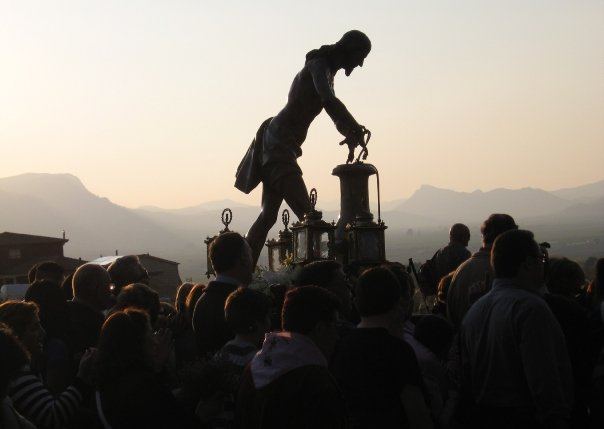Semana Santa (Holy Week) is celebrated throughout Spain, but is especially significant for the people of Jumilla, as their Semana Santa is the oldest one in the region of Murcia and considered to be of National Touristic Interest. Semana Santa lasts for more than a week. I don’t know whether this is generally the case in Spain or a Jumillano trait, but most events referred to as occurring over a “week” are 10 days or more!. It is one of the highlights of the year for Jumillanos, who are justly proud of their tradition.
The first Semana Santa celebrations in Jumilla were held in 1411, inspired by the preaching of St Vincent Ferrer in the old church of Santa Maria de Gracia, which was situated in the original town of Jumilla, beside the Castle. A new church Santa María de Rabal was subsequently built on the remains of an Islam necropolis, between the years 1430 and 1500, when the population living in the shelter of the castle moved down to the plain. The founding of this church is said to have been inspired by the visit of St. Vincent too. All that remains today however are the main entrance and the church tower.
The first cofradía, or brotherhood, was the cofradía of Vera Cruz y Santo Sepulcro, which originated in 1609. There are now a total of 19 cofradías in Jumilla, with more than 4,500 members, who organise the numerous Semana Santa processions.
Semana Santa starts on Viernes de Dolores (the Friday before Palm Sunday) and finishes on Easter Sunday and on most days there is at least one procession to watch.
Both old and young Jumillanos take part, dressed in traditional costume, either helping to carry one of the countless religious statues, playing in one of the many bands or handing out sweets to the eagerly watching children.
The main “Caramelada” is on Domingo de Resurrección, where Spanish children scramble for the sweets that are thrown on the street, rather than over indulging themselves with chocolate Easter eggs. However in recent years we have spotted Easter eggs on sale in our local Aldi, so we suspect that some children will have the best of both worlds. If you head to Plaza del Rollo for 12 noon on Easter Sunday you will witness the meeting of Jesus and the Virgin Mary there, before the parade down Calle Canovas in front of the eagerly awaiting children clutching their plastic bags.
There will be three “tamboradas” this year for those of you who enjoy listening to drums. The main drumming sessions will be on Saturday 23 and Saturday 30 March, with the drummers marching from Plaza de Arriba to the parking area behind the indoor market. Friends of ours who live near there usually ask to visit us for the night rather than try to sleep with drums being banged enthusiastically outside their apartment until the early hours of the morning!
The children’s tamborada will take place on Monday 25 March at 17.00 and the children will march from Plaza de Arriba to the Paseo Lorenzo Guardiola. Needless to say the children don’t drum through the night, though many children can be seen still beating their drums as they walk back home!
Wine always features in Jumilla´s Semana Santa, as well as during other fiestas. This year the popular Miniferia del Vino will be held between 12 and 3 on Saturday 23 March in the Jardin del Rey Don Pedro. For a nominal sum you can purchase a wine glass and then wander around the stands sampling some of Jumilla’s best wines, with nibbles of cheese, ham, bread etc to accompany your wine.
Other highlights during Semana Santa include the following:
Palm Sunday. This is the occasion where Jesus rides through the streets of Jumilla on a donkey, only stopping when proud parents pass their babies to him for photos: inevitably this means that this is the slowest procession! The procession leaves St John the Baptist Church at 12 noon approximately.
The Procession of Silence. This is held late at night and all the lights in the old town are switched off, with only a few bonfires to light the way for the penitents, some of whom have bare feet as they drag chains behind them. The procession will leave Santiago Church at midnight on Tuesday 26 March.
“El Prendimiento” This dramatic re-enactment of the taking of Jesus includes scenes of the devil tempting Christ and the angels singing encouragement to him. Although the angels were sweet, the devil had the best lines and was loudly applauded! The drama takes place in Plaza Arriba at 17.30 on Wednesday 27 March.
The visit to the Monuments, popularly known as Las Manolas. The señoras parade in their finery, wearing traditional mantillas and staggeringly high heels, accompanied by the señors from the cofradías dressed in their robes or their smartest suits. They will be parading down Calle Canovas, near the tourist office, from 17.30 on Thursday 28 March.
I will be updating this post next Thursday with further details of days, times and other events, so please return then!




